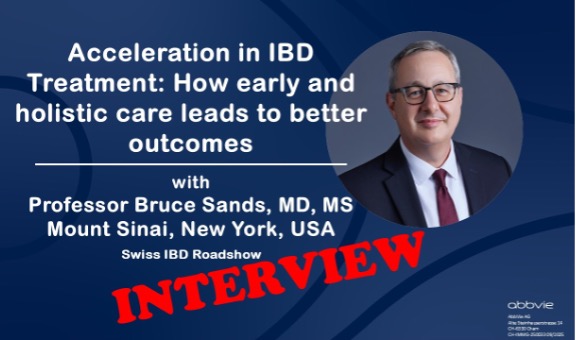Sneak peek of our interview with Prof. Bruce Sands
What was the most important message from your IBD roadshow presentation that you would like to pass on to the participants?
Do not be afraid to use the most effective therapy right at the start. With CD in particular, there is a critical window of opportunity that can make a big difference in the later course of the disease [1,2]. Today, it no longer makes sense to delay the best treatments, and thanks to the availability of well-tolerated therapies, starting early is no longer as daunting as it used to be.
How can a holistic monitoring approach help to achieve treatment goals even more consistently?
Of course we want patients to feel better. However, it is also important that they go beyond symptom control so that inflammatory processes are stopped and mucosal healing is achieved. These healing processes take time, and we can monitor their progress through regular checks of symptoms and biomarkers such as CRP and calprotectin in the stool. After four to six months of therapy for ulcerative colitis (UC) or six to nine months for CD, we can then check progress by means of colonoscopy. Ultimately, monitoring helps us to achieve and maintain the treatment goal for those affected. Unfortunately, despite newer treatment options, many patients still lose their response over time, which can be detected early through monitoring, thereby preventing disease flare-ups and the use of corticosteroids [3-5].
Full article will be published on 11.09.25 in GastroMag.
Abbreviations: CRP = C-reactive protein; IBD = inflammatory bowel disease; MR = magnetic resonance
- Noor NM et al. Lancet Gastroenterol Hepatol. 2024 May; 9(5): 415-427.
- Colombel JF et al. Gastroenterology. 2017 Feb; 152(2): 351-361.e5.
- Vootukuru N et al. World J Gastroenterol. 2024 Jun 14; 30(22): 2902-2919.
- Tibble JA et al. Gastroenterology. 2000 Jul; 119(1): 15-22.
- Colombel JF et al. Lancet. 2017 Dec 23; 390(10114): 2779-2789.
References can be requested by health care professionals via medinfo.ch@abbvie.com.
This content was sponsored by AbbVie AG, Alte Steinhauserstrasse 14, CH-6330 Cham.
